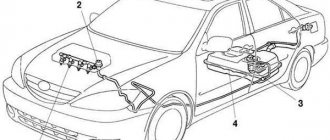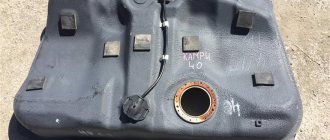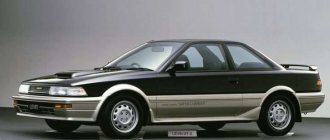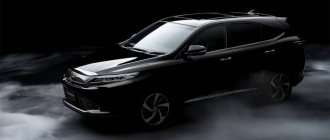Toyota Camry is one of the most popular models of this manufacturer on the Eastern European market. The Japanese concern has been producing Camry since 1982, and as of 2021, seven generations have already been produced. Cars of this model are classified as middle or business class, depending on the generation, and in some countries even as Premium.
Obviously, over the 34 years of production, both the appearance and technical characteristics of the car have undergone radical changes. Especially for lovers of automotive history, we have prepared material revealing changes in the body of the Toyota Camry over the years.
First generation (1982-1986)
This car was first released in 1982 in sedan and hatchback bodies. It featured an angular interior and exterior design, but at the same time it looked very stylish and laconic. The first generation Camry offered the following technical specifications:
- Engine: petrol 1.8, 2 liters
- Transmission: manual / automatic
- Maximum speed: from 160 (1.8, automatic) to 175 km/h (2, manual)
- Acceleration: 11 s (2, manual) -13 s (1.8, automatic)
- Average fuel consumption per 100 km: 8.5 l (1.8, manual) -9.8 l (2, automatic)
Toyota Camry 1st generation: outside and inside
Possible technical faults
- clogging of the engine idle valve with foreign particles;
- failure of the radiator due to mechanical damage and the use of low quality antifreeze;
- broken timing belt (applies only to engines with a V-shaped block);
- destruction of the bearing in the tension roller of the attachment drive belt;
- contamination of the fuel injection system injectors;
- failure of the steering rack guide bushings;
- deformation of the front brake discs due to overheating;
- destruction of anti-roll bar struts and hinges in the suspension arms.
The described breakdowns occur due to natural wear and tear of parts. The service life of components depends on the quality of the spare parts used, the frequency of maintenance and operating conditions. For example, it is recommended to replace antifreeze every 2 years (using original materials). Otherwise, sediment begins to form in the liquid, settling on the walls of the pipelines and impairing engine cooling.
Second generation (1986-1991)
The new model was a success among car enthusiasts (especially on the American continent) and four years later a new generation was released in sedan and station wagon bodies. The updated version has increased in size, and its exterior and electronics have undergone some changes. Improved materials were used to decorate the interior. The modernization also affected technical characteristics:
- Engine: petrol 1.8, 2 or 2.5 liters, diesel 2 liters
- Transmission: manual / automatic
- Maximum speed: from 165 (1.8 l, auto) to 210 km/h (2.5 l, manual)
- Acceleration: 9.5 s (2 l, gasoline, manual) -14.4 s (2 l, diesel, automatic)
- Average fuel consumption per 100 km: 8 liters (2 liters, diesel, auto) – 11 liters (2.5 liters, petrol, auto)
Toyota Camry 2nd generation
Camry salon 2nd generation
Third generation (1992-1996)
Compared to the previous version, the new Camry's dimensions have increased significantly: the length was now 4,725 m (versus 4,520 m for its predecessor), and the width was 1,770 m (versus 1,690). This model was offered in three body styles: sedan, station wagon and coupe. A sports modification has appeared, featuring a stiffer suspension. The interior design was changed: the general outlines acquired smoother shapes. Technical characteristics have also been improved:
- Engine: petrol 2, 2.2 or 3 liters:
- Transmission: 4-speed automatic / 5-speed manual
- Maximum speed: 225 km/h (3 l, gasoline, mech.)
- Acceleration: 8.8 (3 l, petrol, manual) – 11 (2.2, petrol, auto)
- Average fuel consumption per 100 km: 7.8 (2 l, diesel, manual) – 11.2 (3 l, gasoline, auto)
Toyota Camry sedan 3rd generation
Camry station wagon 3rd generation
Camry salon 3rd generation
Technical data
The standard equipment was equipped with a 2.4-liter 2AZ-FE engine with 152 horsepower and a VVT-i system that automatically determines the change in valve timing and the duration of the open state of the intake valves. The system maintained optimal traction at all speeds and engine elasticity. Its exhaust system featured two powerful ceramic-filled catalytic converters that maintained Euro 4 emissions purity. A car with such an engine and a five-speed manual gearbox reached the 100-kilometer mark in 9.4 seconds, its top speed was 210 km/h.
Another V6 engine with a three-liter volume and a power of 186 horses was intended for a richer configuration. This motor had a long service life and a large power reserve. A 4-speed automatic transmission was offered for it. A car with this engine accelerated to the 100-kilometer mark in 9.1 seconds and picked up a speed of 225 km/h.
The Toyota ACV 30 independent suspension is based on MacPherson struts installed on all generations of Camry. Both the front and rear axles are equipped with anti-roll bars.
By increasing the length of the axles on this model, manufacturers significantly improved the car's stability; now the suspension's response to cornering allowed the driver to feel the car more confidently.
A 4WD all-wheel drive has been developed for the Camry Dragonfly, in which the rear axle is connected by a viscous coupling, and the front axle remains the main and driving one. Effective brake discs on all axles allow the driver to stop in any situation, assisted by ABS with axle force distribution system. Parking sensors installed at the front and rear make parking much easier for the driver.
Fourth generation (1996-2001)
The new generation of Camry saw the world in 1996 in several body styles: sedan, station wagon, coupe and convertible. The wheelbase of the new version has increased by 70 mm. The modernization also affected the internal filling: the new Camry acquired an anti-theft system, airbags, and an immobilizer. Technical characteristics have also undergone changes:
- Engine: 2.2 liters, 131-140 hp; 2.5 liters, 200 hp; 3 liters, 190 hp;
- Transmission: manual/automatic;
- Maximum speed: 195 (2.2 l, auto) – 220 km/h (3 l, auto);
- Acceleration: 9 s (3 l, auto.) – 11.7 s (2.2 l, auto);
- Average fuel consumption per 100 km: 9 l (2.2, mech.) – 11.5 l (3 l, auto).
Toyota Camry 4th generation
Camry salon 4th generation
Fifth generation (2001-2006)
The fifth generation Toyota Camry was presented only in a sedan body. This car was distinguished by smoother and more streamlined body lines, which had a beneficial effect on its aerodynamic properties. The interior of the car was improved, and higher quality materials were used in the finishing. As for electronics, even the basic version was equipped with an ABS system, a motion stabilization system, and airbags. The technical characteristics of the new version influenced its driving performance:
- Engine: 2.4 liters, 4 cylinders, 152 hp; 3 liters, 6 cylinders, 186 hp;
- Transmission: 5-speed manual/4-speed automatic;
- Maximum speed: 200 (2.4 l, auto) – 225 km/h (3 l, auto);
- Acceleration: 9.1 s (3 l, auto) – 10.5 s (2.4 l, mech);
- Average fuel consumption per 100 km: 8.6 l (2.4 l, auto) – 11 l (3 l, auto).
Sixth generation (2006-2011)
The discontinuation of the fifth generation marked the end of sales of this model on the Western European market. From now on, the Camry is sold only in Japan, Eastern Europe and North America. When working on the Toyota Camry 40, engineers slightly changed the body , which you can see in the photo below. The lines have become more sweeping, and the car itself visually looks lighter and more elegant. Technical characteristics have also been modernized:
- Engine: 2.4 liters and 3.5 liters;
- Transmission: 5-speed manual/5-speed automatic; 6-speed automatic (3.5 liter engine only);
- Maximum speed: 205 (2.4 l, auto.) – 230 km/h (3 l, auto.)
- Acceleration: 6.8 s (3 l, auto) – 9.1 s (2.4 l, mech)
- Average fuel consumption per 100 km: 8.5 l (2.4 l, manual) – 9.9 l (2.4 l, auto; 3 l, auto)
Toyota Camry 6th generation
Reviews from car owners
I was the owner of a Camry with right-hand drive, the car had a 2.4-liter engine and a G Four all-wheel drive system. The car was purchased in 2008 with a mileage of 105 thousand km at an auction in Japan. The photo showed all the defects (scratches on the body and interior). Over the next 6 years of operation, I drove another 140 thousand km, and performed maintenance every 10 thousand km. The car was distinguished by a soft interior and rich equipment; there were no problems with ordering spare parts.
Evgeniy, 49 years old, Vladivostok
In 2008, I purchased a 2003 right-hand drive Camry, after delivery, I carried out maintenance with the replacement of antifreeze and installed new winter tires. The car had a suspension stiffness adjustment system, the steering was sensitive, but the car was maneuverable. I had to get used to some of the car's features. For example, the computer calculates fuel consumption in kilometers per liter. Subsequently, he gave the car to relatives who continue to use it (the mileage at the beginning of 2021 exceeded 450 thousand km).
Seventh generation (2011-2016)
The new version, Toyota Camry 50 , has more elegant and solid body , as you can see by looking at the photo below. As for the interior, the interior has become more spacious, and the technical equipment has become more modern. The technical characteristics of the 7th generation Camry deserve special attention:
- Engine: 2.5 l (181 hp), 3.5 l (277 hp);
- Transmission: 6-speed automatic with manual control;
- Maximum speed: 190 and 210 km/h respectively;
- Acceleration: 8 s (3 l) – 9 s (2.5 l)
- Average fuel consumption per 100 km: 7.8 l and 9.3 l, respectively.
Toyota Camry 7th generation
This year, the Japanese manufacturer released a restyled Toyota Camry 2016-2017 in a new body , which you can see in the photo below. The body of the Toyota Camry 55 has a more aggressive design thanks to the updated bumper shape and enlarged air intake (see photo ). 2017 Toyota Camry in the new body , shown in the photo shine to the chrome strip above the radiator, slightly modified shape of the headlights and fog lights located in a special niche on the bumper.
New cross-station wagon Toyota Camry: what it could be
Camry is in good demand both in the world in general and in Russia in particular, consistently ranking in the TOP of the most popular cars on the market. At the same time, the model is currently available in only one body type, but we have presented another version that could become very relevant.
Toyota Camry with the index XV70 has been produced since 2021, and in Russia, sales of the sedan began in April 2021. At the end of last May, Camry took 14th place in the TOP 25 best-selling cars on the Russian market. It is the leader in its class and the second most popular Toyota, second only to the RAV4 crossover. Is it possible to make the model even more popular? Quite if you offer a new body option. In the history of the model there were station wagons, starting in 1986 (V20), then in the XV10 generation of the 1992 model. In some markets (for example, Australia), the XV20 generation station wagon has been offered since 1997. Many people probably miss a car like this today, and we have depicted not just a station wagon, but a cross-version of it, which makes the car even more practical. By the way, in a sense, there was a similar car in the Toyota range and it was called Venza - this is an all-terrain station wagon with an original body, made on the basis of the Camry XV40 (the other day we published a large article dedicated to Venza). For some time it was also sold in Russia - from 2013 to 2016, after which the Japanese company optimized its line in times of crisis, and in the new generation Venza turned into a crossover. Now this niche is empty, and the Camry cross-station wagon could certainly become noticeably cheaper than the same Venza, both in development and in implementation, which is especially important during the global economic crisis.
First Camry – V10 1982 – 1986
The history of Toyota Camry began in the early 80s of the 20th century. The very first model, the V10, was developed for the Japanese domestic market. Subsequently, the car was actively sold on the foreign market, from 1982 to 1986.
The ancestor of the first body is considered to be the Toyota Celica Camry sports sedan (1980-1982). But the Camry's wheelbase was increased by one hundred millimeters, which made it possible to achieve more space in the cabin. In addition, the developers decided to move the fuel tank under the rear seat. This led to a significant increase in luggage space.
The location of the engine in the engine compartment has changed. Now it was located transversely. There were 3 types of gasoline engines installed on the cars:
- 1.8 1S-U 100 hp;
- 2.0 2S-ELU 120 horses;
- 2.0 3S-GELU 160 horsepower.
Technical characteristics of Toyota Camry ACV30
Cars of the ASV-30 generation are equipped with an all-metal body, which includes reinforcements for the passenger compartment and deformation zones at the front and rear. The design is designed to accommodate both front and side airbags. The engine with gearbox is installed transversely in the engine compartment; in the event of an accident, the unit falls down. Hydraulic brakes with disc mechanisms (for the US market drums were installed at the rear) are divided into 2 circuits, equipped with an ABS unit with support for traction control and trajectory stabilization systems.
The fuel tank is located inside the wheelbase (in the body well under the rear seat).
The tank capacity and configuration depend on the drive circuit:
- on vehicles with front drive wheels, the volume is 70 liters;
- when installing a rear gearbox and propeller shaft, the capacity is reduced to 65 liters.
Car dimensions
- body length - 4815 mm;
- width (excluding mirrors) - 1795 mm;
- height (modification with front-wheel drive) - 1490 mm;
- wheelbase - 2720 mm;
- wheel track front and rear - 1545 and 1535 mm;
- ground clearance - 150 mm.
Second generation Toyota Camry - V20 1986 - 1990
The second generation Toyota Camry was produced from 1986 to 1990. Compared to the first generation, the rounded shape of the car was clearly visible. Thus, the developers have increased aerodynamic performance.
Gasoline engines for the V20 were used exclusively of the injection type:
- 1.8 1S-i 85 horsepower;
- 1.8 4S-FI 105 hp;
- 2.0 3S-FE 120 horses;
- 2.0 3S-GE 140 hp
There was only one diesel engine for the V20 - 2.0 2C-T 82 hp. (85 horses after the model was restyled in 1988).
All engines were equipped with a manual gearbox or automatic transmission in 5 and 4 stages, respectively.
After restyling in 1988, the top-spec GT (GranTurismo) version appeared. It featured the most powerful engine, a strut under the hood, an improved air conditioning system, a rigid TEMPS sports suspension, and more.
The second generation vehicles were distinguished by increased engine life, high corrosion resistance and improved safety indicators.
Toyota Camry models from 1990 to 2000
From 1991 to 1998, there were several Toyota Camry models in parallel. Small-sized models V30 and V40 were produced for the Japanese market. And the American buyer was offered larger cars, the XV10 and XV20, with a modified design.
V30 body for Japan
The 3rd generation of the legendary Japanese sedan was produced from 1990 to 1994. This body is notable for the new options that have appeared. The most expensive trim levels included a driver airbag and ABS. Also in the expensive Camry V30, the developers installed rear wheel steering (4WS). At the same time, there was a significant price gap between the basic and top configurations.
Different engines were available for the V30:
- 1.8 petrol 4S-FE 115 hp;
- petrol 2.0 3S-FE 135 (140) horses;
- 2.0 petrol 3S-GE 165 horsepower.
A turbocharged diesel engine, 2C-T, was also installed, producing 91 horsepower.
As before, buyers had access to all-wheel drive and two transmissions: 5 manual transmission and 4 automatic transmission. The automatic transmission could operate in winter and sports mode.
The V30 model was restyled in the summer of 1992. After it, the GT package was replaced by a touring package. The list of options for this option included original R15 alloy wheels, a spoiler, foglights, a leather steering wheel, and two-way steering wheel adjustment.
Model Toyota Camry V40
The creation of the fourth generation Toyota Camry was accompanied by a serious economic crisis in the land of the rising sun. In this regard, the developers focused on the practicality of all V40 trim levels.
The power plants of the V40 generation were inherited from the previous V30 model (petrol 1.8 4S-FE, 2.0 3S-FE). Only the diesel engine has changed; instead of the 2.0 2C-T, a 2.2 3C-T (with a power of 90 hp) was installed.
Independent, MacPherson-type spring suspension was installed front and rear. Improved four-wheel maneuverability of the Camry V40 was achieved through the use of the 4WS system.
The 1996 V40 update affected the optics; they became more modern. Also available in the middle trim levels: wood trim, airbags, ABS, remote control key and leather steering wheel.
Body for America XV10 1991 - 1996
Camry, designated XV10, appeared in the United States in 1991 and was sold in three body styles: sedan, station wagon and coupe. The wheelbase of the car was increased to 2620 mm, the length of the body was 4725 mm, and the width was 1770 mm.
The American version of the XV10 was equipped only with gasoline engines: 2.2 5S-FE 125 (130) hp, 3.0 3VZ-FE 185 horses, and after an update in 1994 - 3.0 1MZ-FE 188 horsepower. There were 2 gearboxes - 5 manual transmission and 4 automatic transmission.
Standard safety features included a driver's airbag, front seat belts with load limiters, adjustable head restraints, and anti-lock and traction control systems. For an additional fee, the XV10 was equipped with cruise control and an airbag for the front passenger.
XV20 – the fifth generation of the Japanese sedan
The XV20 model appeared in 1996, replacing the first Camry XV10 wide body. But in Japan, the XV 20 was called the Toyota Camry Gracia until 1998, because at the same time a “narrow” version of the V40 was produced.
In the fifth generation cars, the interior design was completely changed. The interior used high-quality plastic with wooden inserts. The instrument panel was harmoniously combined with the interior. The level of sound insulation in the cabin was not satisfactory. A comfortable position behind the wheel has been designed for the driver. The steering column and lumbar support were adjustable.
The gasoline engines used in the fifth generation Camry sedan were made in two variations: four-cylinder 2.2 5S-FE with a power of 140 hp. and V6 2.5 2MZ-FE, producing 200 horses. This body, like the XV10, did not offer diesel engines. But in the Japanese market, the XV20 retained all-wheel drive in some trim levels.
The V6 2.5 2MZ-FE petrol engine was not offered on the global market for the fifth generation XV20. Instead, the cars were equipped with an older internal combustion engine - V6 3.0 1MZ-FE (194 hp). Also available to buyers was a four-cylinder 2.2 5S-FE with 131 hp.
Car interior
The interior of the car uses soft plastic trim elements, but some parts have a hard structure. The quality of fitting of the components is high, no squeaks were noted even on cars with mileages of more than 400 thousand km. The plant produced sedans with dark or light trim for the lower part of the cabin; on expensive modifications, inserts imitating wood were provided. In the center of the dashboard there is a socket for a radio or navigation receiver, under which there is an air conditioning control panel.
A wide console with an armrest and additional niches for small items is mounted between the front seats. The steering column is adjustable in 2 directions, the seats are adjusted manually or electrically.
The basic chairs were upholstered in velor; expensive modifications included leather trim. Radio control buttons can be installed on the steering wheel. The rear row of seats is equipped with a separate backrest and cushion, which fold down to increase the volume of the luggage compartment.
Toyota Camry sixth generation – XV30 2001 – 2006
This body has significantly increased in size (almost 7 cm in height, the wheelbase has increased by 5 cm). This happened because the main market for Camry was North America, and there the client loves big cars. The XV30 generation was sold between 2001 and 2006.
In the US and Canada, buyers of the XV30 were offered three petrol engines. Among them are 2.4 2AZ-FE 157 hp, 3.0 V6 1MZ-FE 192 (210 horsepower after update) and another V6 3.3 3MZ-FE (225 hp). In America, manual and automatic transmissions were available with the XV30, but there were no all-wheel drive trims.
In Russia, the Camry XV 30 was equipped with two gasoline engines: 2.4 2AZ-FE (152 hp) and V6 3.0 1MZ-FE (186 hp). Mechanics were only available with a smaller engine.
In Japan, the XV30 was available only with a 2.4 2AZ-FE engine producing 159 hp, but you could buy the car with both all-wheel drive and front-wheel drive. In Japan, the XV 30 was better equipped than in other countries. Even the starting 2.4 G version had electrically adjustable front seats and a remote control key.
Appearance and interior equipment
In 2001, a presentation took place and production of the Camry 30 in the ACV body began. The new body acquired even greater aerodynamic perfection, the angular shape disappeared, the contours of the body became smoother, and the shape of the radiator grille and headlights changed.
It is because of the headlights, reminiscent of the compound eyes of an insect, that the Toyota Camry ACV 30 received the affectionate nickname “dragonfly”.
This can be understood by looking at these two photos. (Photo No. 1 and Photo No. 2) True, because of such headlights, the profile of the car lost some of its swiftness, but it gained a special individuality.
In Russia, official dealers sold the Camry Dragonfly in only two trim levels, but even the standard kit was very rich. It included headlights with xenon optics, front and rear fog lights, an in-cabin air purification and temperature maintenance system, a car radio and heated front seats.
For this kit, a set of sensors was required, including windshield wipers at the first drops of rain and head lights in low light conditions (for example, when entering a tunnel). Side mirrors with a water-repellent coating were positioned in such a way as to eliminate the possibility of blind areas.
The second, more equipped, configuration had a parking video camera and front seats with variable backrest tilt and automatic position memory. Additionally, it was possible to install a cruise control system and equip the interior with leather covering, but such options were paid separately. The backrests of the rear sofa could be folded in a 60/40 ratio, they increased the trunk space, which was already huge - 575 liters.
Camry XV50 – the eighth body
Production of the Toyota XV50 began in 2011. Subsequently, the developers made minor amendments to the body. Restyling (2014) of the XV50 body did not bring significant changes, but completely changed the appearance of the car. At the same time, the Camry XV50 had a different appearance depending on the region of production and sale.
The XV50 hybrid engine model was not offered on the Russian market, but three gasoline engines were offered:
- the least powerful 2.0 1AZ-FE was equipped with a 4-speed automatic transmission;
- 2.5 2AR-FE 181 hp
- 3.5 2GR-FE.
The medium and large engines were coupled with a 6-speed automatic transmission.
In the domestic Japanese market, the eighth generation Camry was offered only in a hybrid version. Moreover, a new gasoline internal combustion engine was installed in tandem with an electric motor. Its volume is 2.5 2AR-FXE.
In the States, the XV50 body had three powertrain options. The hybrid version of the car is driven by a pair - an electric motor and an internal combustion engine 2.5 2AR-FXE. Also exclusively petrol engine options were available: 2.5 2AR-FE with a unit power of 178 horses and 3.5 2GR-FE - 268 hp.
Comparison with closest competitors
List of competitors compiled based on owner reviews:
- Mazda 6 generation GG, built on the Ford Mondeo platform. Deliveries of cars began in 2002. The manufacturer offered several types of gasoline engines with power from 120 to 261 hp. With. A modification with a diesel engine was provided. The cars were equipped with a sedan or station wagon body, which made it possible to transport large cargo. The cars have a spacious interior, but the quality of finishing materials and comfort are lower than those of Toyota. An additional disadvantage is the poor corrosion resistance of the body.
- Honda Accord CL series, which has been produced since 2002. The cars were equipped with 2 types of bodies with different sizes (larger for North America and compact, intended for Europe and Japan). The cars are distinguished by the use of motors up to 2.4 liters of sports type. For the domestic Japanese market, versions with all-wheel drive and a station wagon body were offered. Versions with a supercharged diesel engine were assembled in small batches, intended for the Western European market.
- The B5 generation Skoda Superb was based on the Volkswagen Passat B5 platform. The assembly of cars began in 2001. The cars were equipped with gasoline engines up to 3.6 liters, and supercharged diesel engines were offered. Mechanical gearboxes with 5 and 6 steps were installed as standard; expensive modifications received a 5-speed hydromechanical unit. An all-wheel drive version was offered and the transmission included an electronically controlled Haldex clutch.
Ninth Toyota Camry body – XV70
The new XV70 body appeared in 2021. In this generation, engineers designed a single car for all markets, abandoning the development of different designs for the United States, Japan and eastern Europe. In Russia, the new body began to be produced much later than in Japan and the USA. Three gasoline engines are available on the Russian market:
- 2.0 6AR-FSE 150 hp;
- 2.5 2AR-FE 181 hp;
- 3.5 2GR-FKS 249 hp
In America, as in the previous body, there are three engine options:
- hybrid;
- 2.5 A25A-FKS 203 hp;
- 3.5 2GR-FKS.
Technically, the engines have been greatly improved, which is visible to the naked eye when comparing power indicators with previous power plants. Also in the USA and Canada, the XV70 model is sold with an 8-speed automatic transmission.
The new Toyota Camry 70 body has become longer and wider compared to the previous generation. The created design gave the car an expressive appearance.










